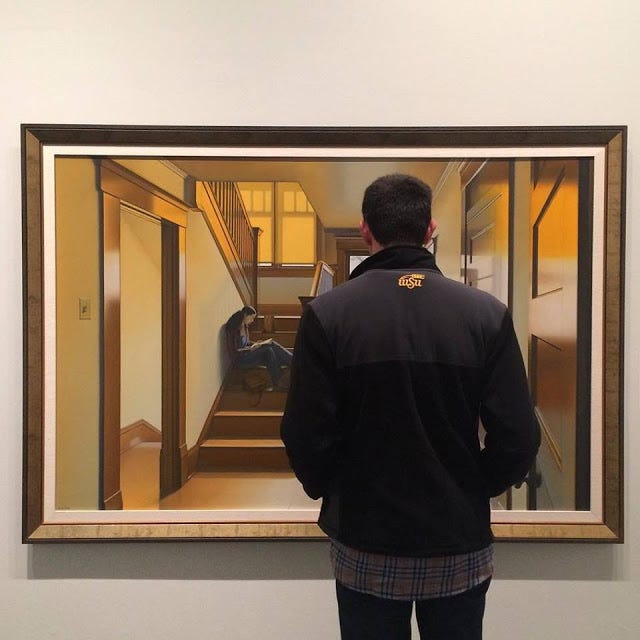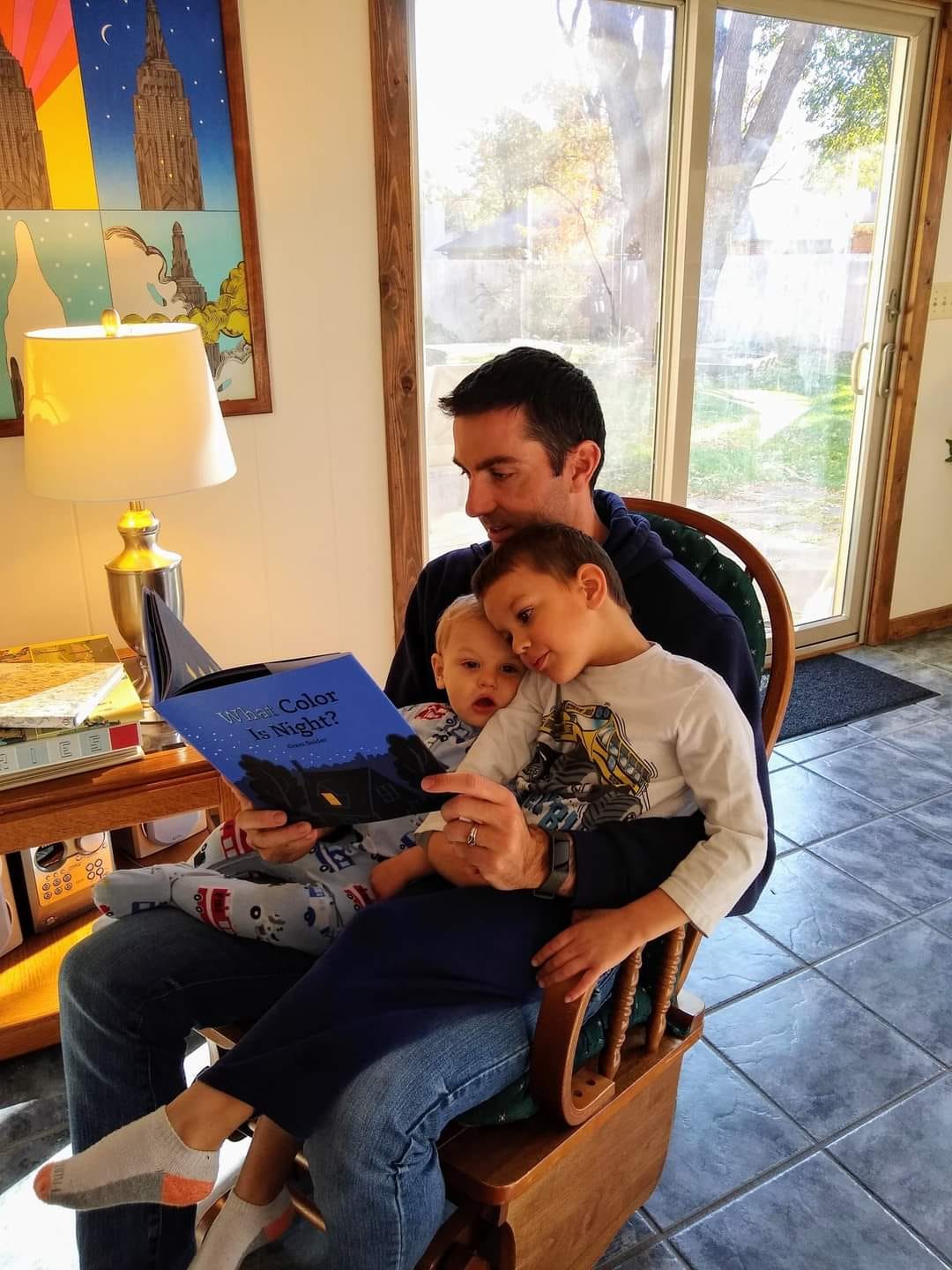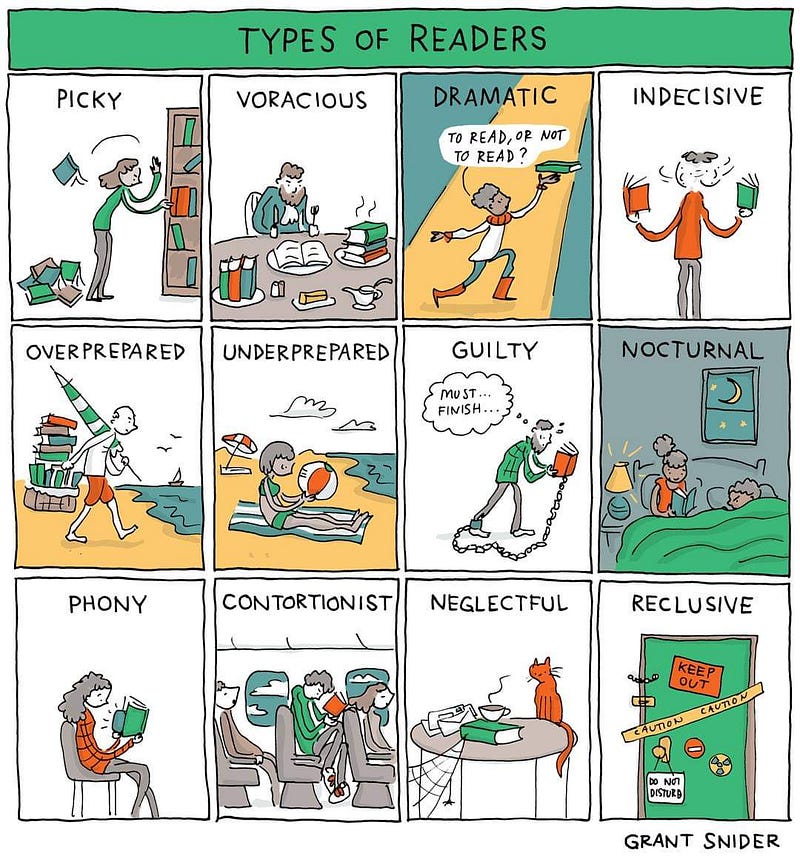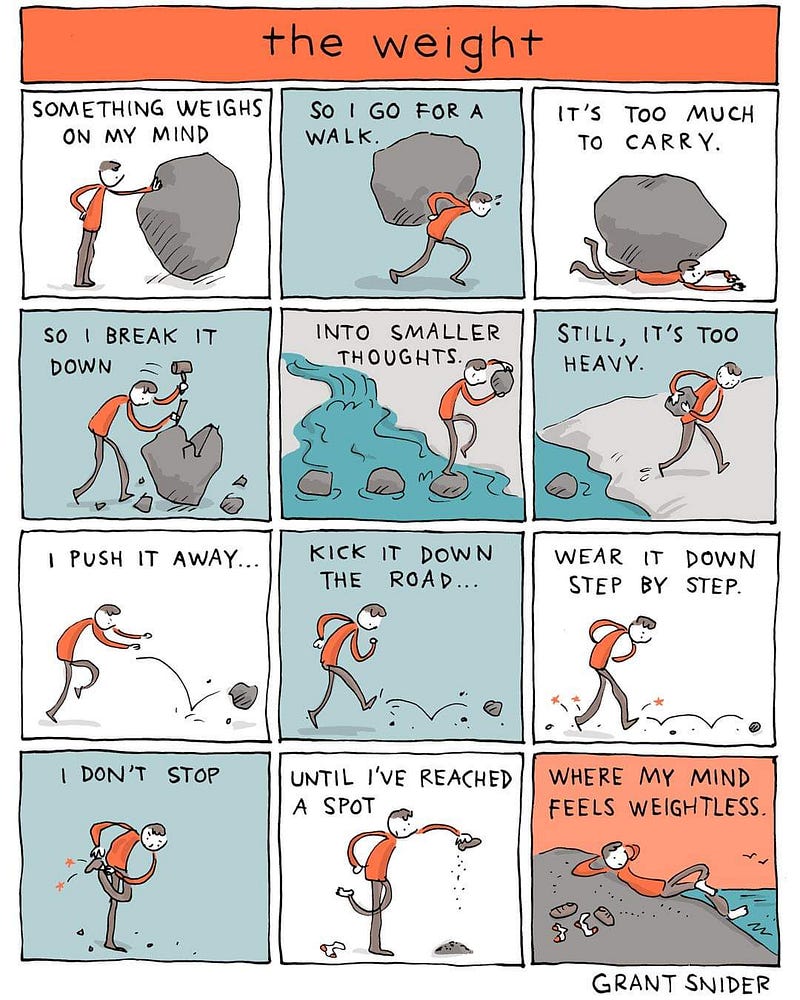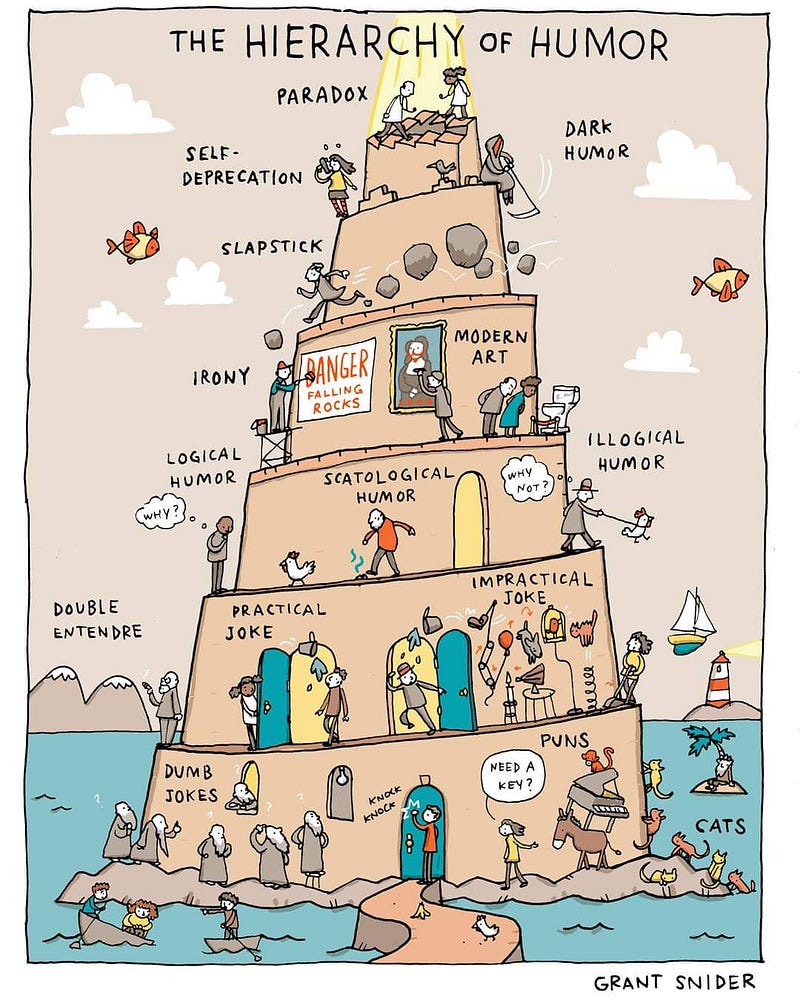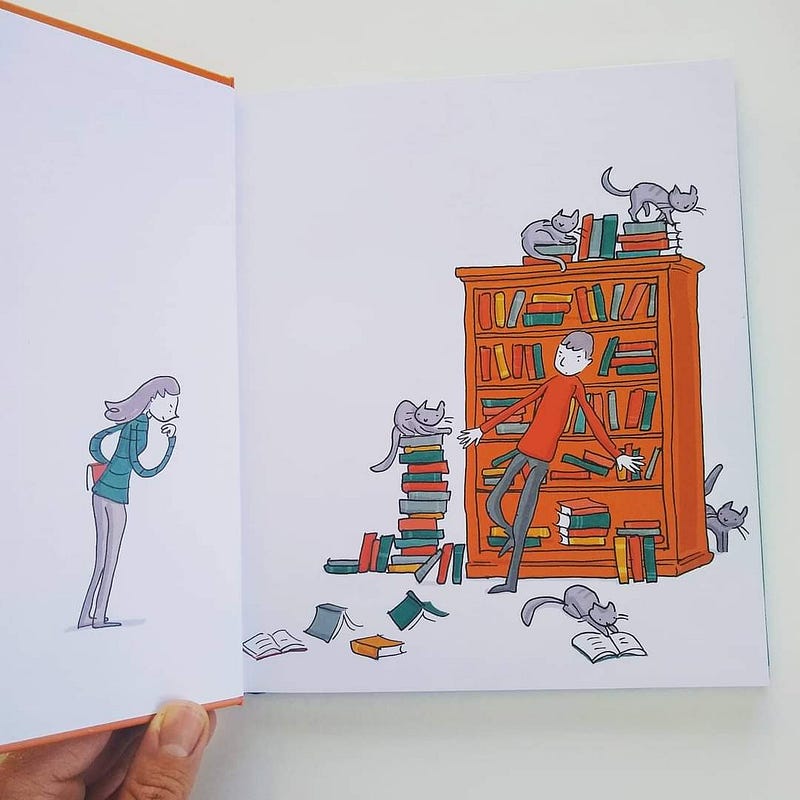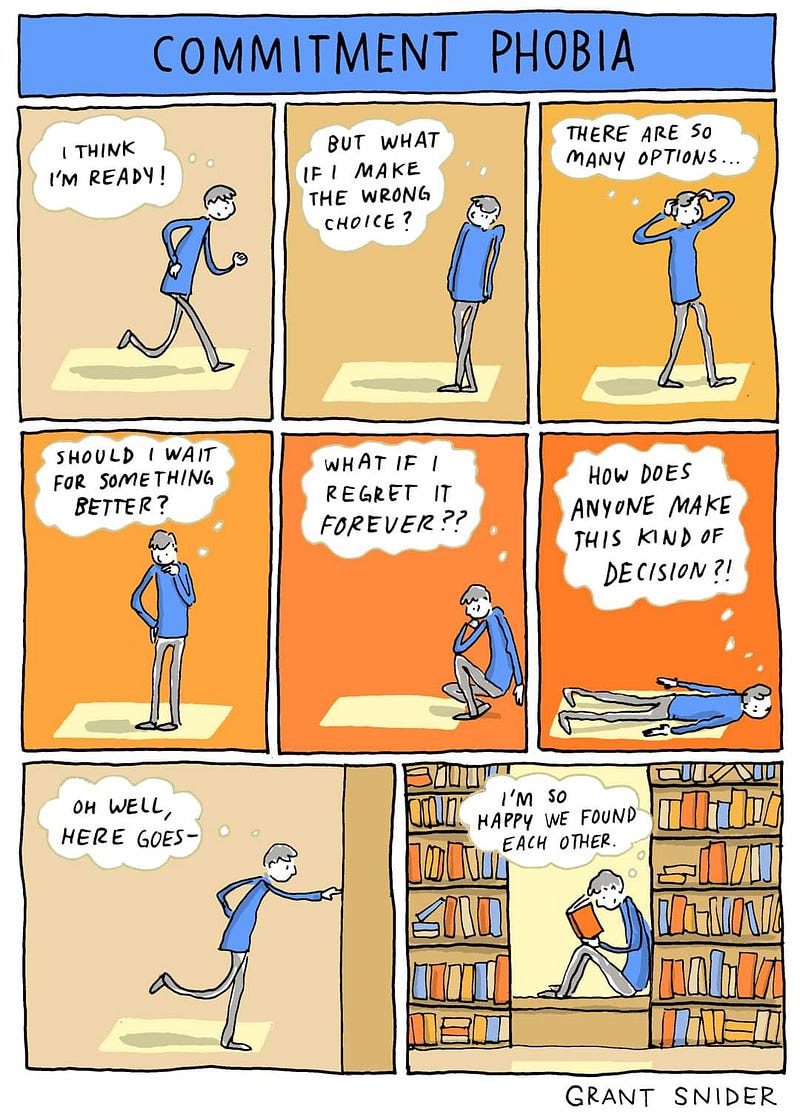The Portrait of A Bookshelf
My First Interview with Grant Snider — Cartoonist, Comic Artist and Writer
An Interview with Grant Snider — Cartoonist, Comic Artists and Writer
Grant Snider is a cartoonist, comic strip artist, and writer.
He had studied engineering at the University of Kansas and then dentistry at the University of Missouri-Kansas City.
In 2009 he launched his online Incidental Comics, featuring strips about art, literature, and the creative process.
INCIDENTAL COMICS
Words and Pictures by Grant Sniderwww.incidentalcomics.com
His strips have been featured in magazines such as The New York Review of Books and The New Yorker and compiled in two books: The Shape of Ideas (2018) and I Will Judge You by Your Bookshelf (2020), the latter a collection of comics about the love of writing and reading.
My New Yorker Cartoon Phase
Just as most teenage boys go through a Led Zeppelin phase, most young cartoonists go through a New Yorker cartoon…www.incidentalcomics.com
Other People's Bookshelves
What does your reading selection say about you? If you invite me over, I will be the judge.www.newyorker.com
His recently published books include I Will Judge You By Your Bookshelf and What Sound is Morning?
A collection of his comics, The Shape of Ideas, was published by Abrams Comic Arts in 2017. His debut children’s picture book, What Color is Night?, was published by Chronicle Books in October 2019.
He started with illustration and writing before he knew what he was doing. Soon it was too late to stop.
When he’s not drawing, Grant does something surprisingly mundane: fixing people’s teeth.
“I think to do this you have to be slightly disassociated with reality,” he says, referring to the cartooning, not his orthodontic practice.
He lives in Wichita, Kansas with his wife, daughter, and three sons, where he also practices orthodontics.
You can often find him carrying a sketchbook, lost in his own thoughts.
Excerpts from the Interview:-
Q1) Grant, could you tell us a little bit about your background and how you got into drawing? Is it something you have always done?
Grant: Drawing has always been an important part of my life. I grew up in Derby, Kansas, in the midwestern United States. We had a big backyard in a neighborhood just outside of town. My parents kept a vegetable garden and fruit trees, and we had lots of room to explore. My twin brother Gavin and I entertained ourselves by creating characters, stories, and imaginary worlds on paper. And I never stopped.
The art of balancing your creative side and realities of life are frequent topics in my cartoons. Cartooning fell into place for me as I was about to start dental school. “ My struggle was I wanted art to be a part of my life, but I didn’t know how. I didn’t know how I was going to find the time and the motivation.”
In college, I used cartooning as a way to blow off steam after a particularly tough class. After sitting in a lecture about tooth anatomy, I could just sit down and doodle and not think about those challenges.
Q2) Who or what inspired you to create comics?
Grant: Reading, always. I went from newspaper comics strips like Bill Watterson’s Calvin and Hobbes to alternative comics like Matt Groening’s Life in Hell to the New Yorker cartoons of Roz Chast. I later fell in love with the literary comics of Tom Gauld and the immaculate linework of J. J. Sempe. Reading the work of other cartoonists and learning by imitation has been one of the most valuable parts of my creative development.
Q3) As an artist who is your greatest influences? Tell us about some of your favorite cartoonists, artists, and writers.
Grant: Apart from the cartoonists I mentioned, I love mid-century American painters like Edward Hopper and Georgia O’Keeffe. My local art museum has a great collection of paintings from that era.
Poets Langston Hughes, Billy Collins, and Ted Kooser inspire me to put words on paper (and even try poetry of my own). Less of a discrete influence has been the imaginative fiction of writers Haruki Murakami and Kelly Link.
Q4) How would you describe your illustrations in three words?
Grant: “Trial and error.”
Q5) What’s your work style? Late nights? Intense creative bursts? Slow and steady wins the race?
Grant: A bit of everything, except for late nights. For the last half-decade, I woke early on weekday mornings, guzzled coffee, and drew before the sun came up and my day job started. It was highly productive, but I was often grumpy and irritable by the time I got home from work. Now I lock myself in a quiet room a couple of days a week and work in furious all-day drawing sessions. Not so furious, actually — I work from 9 AM to 3 PM, often with a break for lunch and a run. Coffee is still a big help.
Q6) What kind of projects have you worked on recently? What was the most challenging? The most rewarding?
Grant: I’ve been working on a couple of picture books for Chronicle Books where I’m illustrating almost entirely in colored pencil. Working with traditional media is rewarding, as there’s much less screen time. But it’s definitely a physical challenge to cover the paper in pencil lines. I’m enjoying the feeling of not fully knowing what I’m doing… I feel a certain level of mastery in my comics style that also closes off the possibility of unexpected insights. It will take many more books if I ever get to that point in my children’s bookmaking.
Q7) Your cartoons often take anecdotes from writers and artists — Haruki Murakami, George Saunders, Georgia O’Keeffe, René Magritte, and many others — in playful, appreciative ways. Any sense of identification with these writer’s life or writings.
Grant: I feel that most great ideas are borrowed, and I enjoy renting the ideas of great artists for the space of a comic. I’m fascinated by the lives of all writers. What a strange discipline, to sit alone in a room and build worlds from imagination. But I love the humor and accessibility of the names you mentioned, apart from their high literary reputation.
Q8) I have observed that there is a presence of poetic elements in most of your comic strips. While I’m on the subject, what other poets have evolved your thought process? And which usually comes first: the poem or the image?
Grant: In the best situations, the words and image arrive together. This doesn’t often happen, but when it does the result is magic. When it doesn’t happen, either the words or pictures must be coaxed into coexisting with the other.
I consider myself a poetry novice, but I love the work of Ted Kooser, Kay Ryan, Billy Collins, Emily Dickinson, Langston Hughes, Naomi Shihab Nye, Robert Frost, and William Carlos Williams. I know, that sounds like a high school poetry syllabus. I also enjoy reading translations of Pablo Neruda and Japanese haiku.
Q9) How do you make the individual become a part of the art that they experience? Is the ability to completely lose oneself to the art that surrounds people something you wish to inspire in your readers as well?
Grant: There’s a balance inputting just the right amount of information into the art. If there is some negative space in the drawing and the language is pared down, the reader has space for some of their own emotion and experience to filter in. Take out too much, though, and it risks being generic or incoherent. Put in too much and it loses its punch. I’ve noticed that my most successful work leaves space for the reader. So it’s not so much losing oneself as finding space to inhabit the art of another.
Q10) How did you decide to write this book: I Will Judge You by Your Bookshelf (2020)? Bits by bits, you had effortlessly captured a lifelong love affair with books, bookstores, and book-sellers that is at once heartfelt and bittersweet. What was the writing process from the beginning to the end? What inspired you?
I Will Judge You by Your Bookshelf
I Will Judge You by Your Bookshelf book. Read 306 reviews from the world's largest community for readers. A look at the…www.goodreads.com
How many years of research or work were put into this project? What message did you want to communicate to your readers through this book?
Grant: This book is a collection of strips taken from my weekly comic I post on incidentalcomics.com. The first one I drew in 2011, the last one in 2019. That’s a lot of years of cartoons, but they were all drawn without a larger purpose in mind.
I hope it communicates the love of reading and the ups and downs of writing in a funny and relatable way. There wasn’t much of a grand plan to create the work, but I always hoped the comics would make it into a book that could be placed on a shelf, thrown across the room, or used as a doorstop.
Q11) You have a lot of different ways that you play with art and books/bookshelf. You’ve illustrated pretty great illustrations of bookshelves and had successfully depicted or juxtaposed reader’s psychology. How did you come up with all of the ephemera in this book?
Grant: Lots of hours spent reading, visiting libraries and bookshops. And taking a cold, hard look at the fact that I have WAY too many books in my house.
Q12) What can you tell about a person by looking at their bookshelves? If you’re dating someone new, or when you’re sketching books at a dinner party, what can you learn?
Grant : It’s a peek into a person’s soul. A bookshelf shows one’s interests, aptitude, and organizational skills. Even a decorative bookshelf where the spines haven’t been cracked is revealing. Of course, I’m not immune to this judgment. Someone visiting my house will notice I really, really like books with pictures.
Q13) Have you always been a book lover? And what initially sparked your reading interest? Are you a bibliophile or a bibliophagist? There’s no mistaking the fact that books are a big part of your world, though you draw all sorts of subjects. What is it about books that are such a rich creative resource for you?
Grant: Through books, we can see another person’s thoughts in the humble form of ink on paper. I can remember poring over picture books as a child and getting lost in their worlds. But I would consider myself more of a bibliophagist, as I’m not too concerned with what happens to the book after I’ve read it. For better or worse, I rarely re-read novels. And the comics collections and picture books I love are ripped, dog-eared, and scribbled-on by myself and my children.
Q14) According to you, why do Independent Bookstores matter?
Grant: I see independent bookstores as a vibrant center for local literary culture. Apart from the chance to browse and buy unexpected books, I’ve seen many inspiring authors and illustrators speak in person.
Q15) It’s unhealthy to tie self-esteem to creative output, but it’s part of an artist/writer personality at some point. Do you agree? How do you get over creative blocks?
Grant: Yes, I absolutely agree. A creative block, though inevitable, is a sign I need to step away from my work. Go on a walk, take in new art, spend time with my family. “Social distancing” from one’s work is important to avoid burnout. It also helps when I revisit old sketchbooks to find new sparks. Going back in time to rekindle old ideas can be more valuable than trying to force new ones.
Q16) What’s something important you learned in the process of publishing your books or comics?
Grant: The process of creating the work is the only thing the author or artist can control, everything else is up to the audience and the weather. And a chance.
Q17) Why do you think it’s important to have a dedicated workspace for your art?
Grant: I think of my workspace as a playground for ideas. It’s set aside for the explicit purpose of creativity. The hours I spend there are intentional and solitary. I can be as disorganized as I want to be.
Q18) What advice would you give to artists looking to build a creative workspace?
Grant: A common thought or mindset when you sit down to create something fresh is that you can’t beat what you did before, and that inhibits creativity and the ability to do new work. You have to devise a new strategy each and every time. That’s what creativity is all about. You have to start fresh each time and not be influenced by things that have worked well for you in the past.
Establish a predictable routine, but be open to bursts of inspiration. Don’t neglect to wander aimlessly outdoors. Find a door that locks.
Thank you all for reading and a big thanks to Grant Snider for collaborating in today’s post!
It’s a pleasure!
If any of my readers here, wish to know more about Grant Snider and his work. Do open the links mentioned below. It has all the essential details about his books, blog, and upcoming events.
Website: https://www.grantsnider.com/
Facebook: https://www.facebook.com/incidentalcomics/
Instagram: https://www.instagram.com/grantdraws/
Twitter: https://twitter.com/grantdraws
Medium: https://medium.com/@grantdraws






